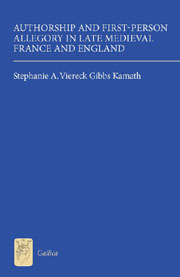Book contents
- Frontmatter
- Contents
- Dedication
- Acknowledgements
- Abbreviations
- A Note on Names, Sources, and Translations
- Introduction
- 1 “Comment ot nom”: Allegory and Authorship in the Roman de la Rose and the Pèlerinage de la Vie Humaine
- 2 “What so myn auctour mente”: Allegory and Authorship in Geoffrey Chaucer's Dreams
- 3 “Thereof was I noon auctour”: Allegory and Thomas Hoccleve's Authority
- 4 Verba Translatoris: Allegory and John Lydgate's Literary Tradition
- Coda
- Bibliography
- Index
- ALREADY PUBLISHED
2 - “What so myn auctour mente”: Allegory and Authorship in Geoffrey Chaucer's Dreams
Published online by Cambridge University Press: 05 February 2013
- Frontmatter
- Contents
- Dedication
- Acknowledgements
- Abbreviations
- A Note on Names, Sources, and Translations
- Introduction
- 1 “Comment ot nom”: Allegory and Authorship in the Roman de la Rose and the Pèlerinage de la Vie Humaine
- 2 “What so myn auctour mente”: Allegory and Authorship in Geoffrey Chaucer's Dreams
- 3 “Thereof was I noon auctour”: Allegory and Thomas Hoccleve's Authority
- 4 Verba Translatoris: Allegory and John Lydgate's Literary Tradition
- Coda
- Bibliography
- Index
- ALREADY PUBLISHED
Summary
By the final quarter of the fourteenth century, the interpretation, citation, and circulation of the Rose had reached a level unprecedented for a vernacular text, and the strategy of attributing authorship to the first-person narrator-protagonist of an allegorical vision was widespread. The previous chapter studied the deployment of this strategy in one of the earliest and most widely read allegories directly citing the Rose, the mid-fourteenth-century Pèlerinage de la Vie Humaine (PVH), written and revised by Guillaume de Deguileville. Deguileville continued experimentation with the strategy in the two later allegories completing his Pèlerinage trilogy, and his abiding interest in the Rose and in what we can term “first-person allegory” was far from singular, shared by other influential vernacular authors including Dante Alighieri, Guillaume de Machaut, and Giovanni Boccaccio. Even European manuscript art of this period, witnessing efforts to depict both the intradiegetic and the extradiegetic roles of the narrator, reflects the influence of the Rose's innovation. This is the cultural climate in which Geoffrey Chaucer (c. 1340–1400) began writing first-person narratives in English. Today, Chaucer's corpus is recognized as foundational to later English literary history. Yet it is in terms of a wider European tradition that Chaucer defines his authorship within his works, and the allegorical strategies inviting attention to authorship in the Rose and in Guillaume de Deguileville's poems are of particular importance to Chaucer, as his choices in translation and in composition reveal.
- Type
- Chapter
- Information
- Publisher: Boydell & BrewerPrint publication year: 2012



